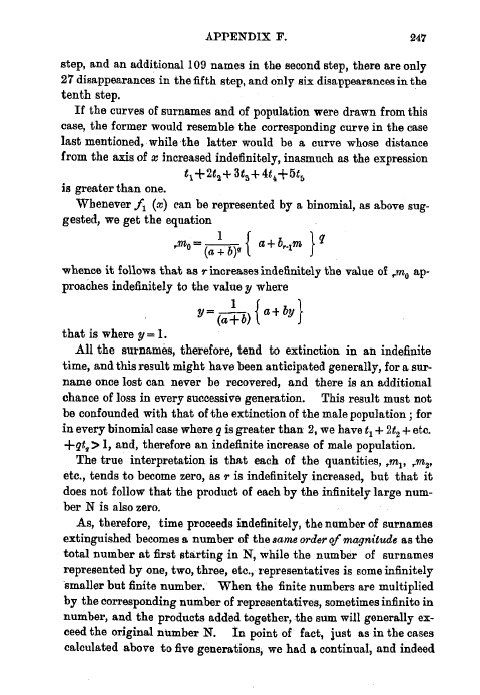APPENDIX F. 247
step, and an additional 109 names in the second step, there are only 27 disappearances in the fifth step, and only six disappearances in the tenth step.
If the curves of surnames and of population were drawn from this case, the former would resemble the corresponding curve in the case last mentioned, while the latter would be a curve whose distance from the axis of x increased indefinitely, inasmuch as the expression
tj+2t2+ 3ts+ 4t4+ U5
is greater than one.
Whenever fi (x) can be represented by a binomial, as above suggested, we get the equation
rm0 (a + b)Q { a + 6,1M j q
whence it follows that as r increases indefinitely the value of rmo approaches indefinitely to the value y where
y= I a+ by
(a+b)
that is where y =1.
All the surnames, therefore, tend to extinction in an indefinite time, and this result might have been anticipated generally, for a surname once lost can never be recovered, and there is an additional chance of loss in every successive generation. This result must not be confounded with that of the extinction of the male population ; for in every binomial case where q is greater than 2, we have ti + 2t2 + etc. +qt,> 1, and, therefore an indefinite increase of male population.
The true interpretation is that each of the quantities, rm,, rm2, etc., tends to become zero, as r is indefinitely increased, but that it does not follow that the product of each by the infinitely large number N is also zero.
As, therefore, time proceeds indefinitely, the number of surnames extinguished becomes a number of the same order of magnitude as the total number at first starting in N, while the number of surnames represented by one, two, three, etc., representatives is some infinitely smaller but finite number.' When the finite numbers are multiplied by the corresponding number of representatives, sometimes infinite in number, and the products added together, the sum will generally exceed the original number N. In point of fact, just as in the cases calculated above to five generations, we had a continual, and indeed

